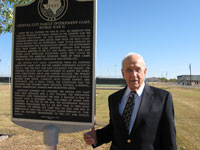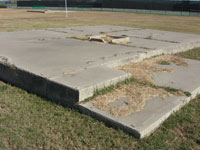Home | back to the Programs page
January 14, 2009 · 82-year old Eberhard Fuhr says he has lived the American dream. Growing up in Cincinnati, Fuhr was called "Eb" by his friends and spent much of his time playing sports, including high school football. "We had a rotten team. We lost every game," he reminisces. While Fuhr described his childhood as idyllic, a dark shadow was cast on his own personal history. One day in March of 1943, 17-year-old Fuhr was arrested. He was just six weeks shy of graduating. "I was in my classroom at about 2 o’clock in the afternoon. The principal came in and asked me to step into the hallway. I was arrested by two FBI agents," he said. As he was being led away, Fuhr was aware that he might never see his friends at school again. "They didn’t cuff me inside the school, but the minute we left the front door I was cuffed," he said. Fuhr was charged with being an enemy alien for the German government and put in detention. He came to the United States with his parents when he was 3-years-old and was still a nationalized German. His parents had already been arrested and put in a internment camp 8 months earlier. Now Eb and his U.S. born little brother were joining them in Crystal City, Texas. Fuhr would spend the next four and half years in government custody, most of it at Crystal City, which was the site of the largest German internment camp in the nation. Click here for a drawing of the internment camp. The Department of Justice made what some call a propaganda film about the Crystal City camp. A Department of Justice film on the Crystal City Internment Camp. "Here’s a party of women and children arriving in Crystal City following their voluntary decision to join fathers and husbands in detention. Practically all the children and many women were American born," she says. The scratchy 10-minute color film documents day-to-day life in the camp and how the U.S. government cared for the internees. The narrator reads "People who had to be isolated for medical purposes were placed in cottages like this, which were equipped with modern conveniences. Ills were often imaginary, traceable to detention — the fence – the loss of freedom." Fuhr remembers that the years in the camp were difficult for his mother. "She was a typical German haus frau, and this is why I tell this story. She was interned at the age of fifty-three and not released until fifty-nine, and I just feel compelled to tell that story." For years, many of the German internees were silent about their experiences in the camps. While the Japanese who were detained were organized, vocal and able to receive an apology from the United States government, the Germans seem almost embarrassed. "Karen Ebel's father Max Ebel was a German citizen interned in the United States during World War II. She said her father kept his experiences secret for most of his life." "He actually didn’t ever talk about it until he was in his eighties, and I was rather shocked to learn that he was in an internment camp during World War Two," she said.
Ebel founded the German American Internee Coalition, which is pushing the government to take a new look at the internment program and ask some questions. "What happened with the German-Americans and the Italian-Americans and the German and the Latin Americans who were brought up here? There were many Latin Americans who were brought up here from nineteen different Latin American countries," she said. Ebel says the Department of Justice program was massive at a time when the government was scrambling for resources to fight WWII. But did the program make the United States any safer? None of the German-Americans were found to have been spies or saboteurs for the Nazis. Ebel says the legal process that put people in detention camps was not concerned with questions of innocence, just being a suspect made you guilty. And something as simple as subscribing to a German newspaper was enough to make you a suspect. "They had no right to counsel. They couldn’t question the proceedings. They couldn’t question their accusers. It was pretty much a slam dunk process," "The system wasn’t very practical. It wasn’t very effective. There were many more cost-effective and human resource-effective ways to have done this, but, in effect, we put fifteen thousand German-Americans, about six thousand Italian-Americans and one hundred and twenty thousand Japanese-Americans in camps. That’s a lot of people," said Luick-Thrams. He said he wants to more people to know about the internment policy of the United States government because it is our history and also because it is still current U.S. law that allows the construction of enemy alien internment camps to be built. "In this country do we really round people up in the middle of the night, put them behind twelve foot tall barbed wire fences with searchlights and guards, and then give them no lawyers to get themselves out? Don’t we give people the opportunity to explain themselves? How do we want to live in this country? So those histories are much more relevant to how we live today than calico bonnets and log cabins," he said. San Antonio Congressman Charlie Gonzalez has signed on as a co-sponsor of the bill for the House. He said there is the opinion that the nation should forget about the camps, that it was wartime and people were afraid. "Fear does a strange thing to rational people and we no longer act in a rational fashion. I think we forever have to be mindful of that. And I think that we can go back and look at those circumstances will serve us well in the future, as we speak, as a matter of fact," Gonzalez said. Eberhard Fuhr remembers life in the WWII camp "Should the United States have an internment policy for national emergencies? And if they do have it, what’s the best and the right way to do it without violating to many civil and human rights?" he asks. Eb is standing in an open field in Crystal City as he tells his story. It’s where the camps front gates used to swing shut and lock. All that remains are several foundation slabs and a rusty, leaning flag pole. In 1948, a year after Eb was finally released; he married a fellow former detainee that he met in Crystal City. They started a family, and he climbed the corporate ladder. "And I retired in 1990, and I’ve been leading a life of leisure ever since," he said. That’s why Eb Furer, former enemy alien to the United States says, he’s lived the American dream. Just only his dream had some nightmare years. | Home | |
|||||||



